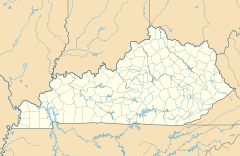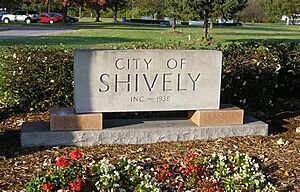Shively, Kentucky facts for kids
Quick facts for kids
Shively, Kentucky
|
|
|---|---|

Location of Shively in Jefferson County, Kentucky
|
|
| Country | United States |
| State | Kentucky |
| County | Jefferson |
| Incorporated | 1938 |
| Government | |
| • Type | Mayor–council government |
| Area | |
| • Total | 4.58 sq mi (11.86 km2) |
| • Land | 4.57 sq mi (11.84 km2) |
| • Water | 0.01 sq mi (0.02 km2) |
| Elevation | 453 ft (138 m) |
| Population
(2020)
|
|
| • Total | 15,636 |
| • Density | 3,419.95/sq mi (1,320.55/km2) |
| Time zone | UTC-5 (Eastern (EST)) |
| • Summer (DST) | UTC-4 (EDT) |
| ZIP codes |
40216, 40256
|
| Area code(s) | 502 |
| FIPS code | 21-70284 |
| GNIS feature ID | 2405462 |
Shively is a city in Jefferson County, Kentucky, United States. It is a suburb of Louisville and part of the Louisville Metro government. In 2010, about 15,264 people lived there.
Contents
A Look at Shively's Past
Early Beginnings and Growth
After Louisville was settled in 1778, farms started to spread into the nearby areas. Early landowners included William Pope and Abner Field. The Shively family, Christian William and Jacob, also owned land.
Christian Shively opened a mill and a tavern. This was on his large piece of land near Mill Creek. This area became the center of a new settlement. It was known as the Shively precinct. He gave land for a church in 1816, which is now Parkview Methodist.
A place for stagecoaches to stop opened in 1831. Later, a railroad arrived in the 1870s.
German Immigrants and New Names
Before the Civil War, many German immigrants moved to the area. Most of them came from Bavaria. They built St. Helen's Catholic Church in 1897.
For a few years, the community was called St. Helen's. However, the post office, which started in 1902, could not use this name. This was because another town in Lee County already had the name St. Helens.
A streetcar line was added to the area in 1904. This made it easier for people to travel.
The Rise of Distilleries
After Prohibition ended, eight whiskey distilleries opened nearby. Prohibition was a time when making and selling alcohol was illegal.
During the Great Depression, Louisville tried to take over these distilleries to tax them. The distilleries convinced the people of Shively to form their own city instead. Shively officially became a city on May 23, 1938.
This meant the distilleries' money went to Shively. The city became very rich. It was the fastest-growing city in Kentucky during the 1950s. Many people moved there from Louisville as suburbs grew.
Overcoming Segregation
For a long time, Shively was a neighborhood mainly for white people. This was due to unfair rules called Jim Crow. In 1954, an African American veteran named Andrew Wade IV and his wife Charlotte wanted to buy a home there.
They got help from activists Carl and Anne Braden. The Bradens bought a house for the Wades. Soon after, the Wades' home was attacked. This included rocks thrown through windows and shots fired. A bomb also exploded near their home, but no one was hurt.
This news made national headlines. Anne Braden wrote a book about it called The Wall Between. The Bradens were even charged with a crime for helping the Wades. Carl Braden went to prison for a short time.
After the attack, the Wades left. For many years, few other black families moved to Shively. It was known as a "sundown town". This meant black people were not welcome after dark.
However, things began to change in the 1970s. The unfair separation slowly ended. Today, about 30% of Shively's population is black. This is a higher percentage than in the larger Louisville area.
Changes and Modern Times
In the late 1960s, most of Shively's distilleries closed. This was due to higher taxes and changing tastes. Shively's population has slowly gone down since 1970.
The city tried to add more land in 1984 but did not succeed. However, things have gotten better recently. There have been public projects, and some new businesses have moved in.
Shively still has strong ties to the bourbon industry. One major distillery, Brown-Forman's Early Times distillery, still operates there. It makes famous brands like Early Times and Old Forester.
Another old distillery site, the former Stitzel-Weller distillery, is now a tourist spot. It is part of the Kentucky Bourbon Trail. This trail lets visitors learn about bourbon history.
The Bernheim Distillery, which makes Heaven Hill Distilleries products, is also nearby. It opened around 2000.
Shively's borders are roughly Millers and Bernheim Lane to the north. Louisville's Seventh Street is to the east. I-264 is to the west. Rockford Lane is to the south.
Shively's Location and Size
Shively is located where US 60 and the Dixie Highway (US 31W) meet. The city covers about 4.6 square miles (11.9 square kilometers) of land.
Who Lives in Shively?
Population Changes Over Time
| Historical population | |||
|---|---|---|---|
| Census | Pop. | %± | |
| 1940 | 1,273 | — | |
| 1950 | 2,401 | 88.6% | |
| 1960 | 15,155 | 531.2% | |
| 1970 | 19,139 | 26.3% | |
| 1980 | 16,645 | −13.0% | |
| 1990 | 15,535 | −6.7% | |
| 2000 | 15,157 | −2.4% | |
| 2010 | 15,264 | 0.7% | |
| 2020 | 15,636 | 2.4% | |
| U.S. Decennial Census | |||
The table above shows how Shively's population has changed. In 2020, the city had 15,636 people.
Diversity in Shively
| Race / Ethnicity (NH = Non-Hispanic) | Pop 2000 | Pop 2010 | Pop 2020 | % 2000 | % 2010 | 2020 |
|---|---|---|---|---|---|---|
| White alone (NH) | 10,121 | 6,835 | 5,080 | 66.77% | 44.78% | 32.49% |
| Black or African American alone (NH) | 4,573 | 7,385 | 8,533 | 30.17% | 48.38% | 54.57% |
| Native American or Alaska Native alone (NH) | 39 | 25 | 39 | 0.26% | 0.16% | 0.25% |
| Asian alone (NH) | 63 | 100 | 110 | 0.42% | 0.66% | 0.70% |
| Pacific Islander alone (NH) | 0 | 12 | 7 | 0.00% | 0.08% | 0.04% |
| Some Other Race alone (NH) | 17 | 47 | 54 | 0.11% | 0.31% | 0.35% |
| Mixed Race or Multi-Racial (NH) | 133 | 319 | 678 | 0.88% | 2.09% | 4.34% |
| Hispanic or Latino (any race) | 211 | 541 | 1,135 | 1.39% | 3.54% | 7.26% |
| Total | 15,157 | 15,264 | 15,636 | 100.00% | 100.00% | 100.00% |
The census helps us understand the different groups of people living in Shively. In 2020, about 54.57% of the population was Black or African American. About 32.49% was White. People of Hispanic or Latino background made up about 7.26% of the population.
Learning and Libraries
Shively has a lending library. It is a branch of the Louisville Free Public Library. This means people can borrow books and other materials there.
Images for kids
See also
 In Spanish: Shively (Kentucky) para niños
In Spanish: Shively (Kentucky) para niños





